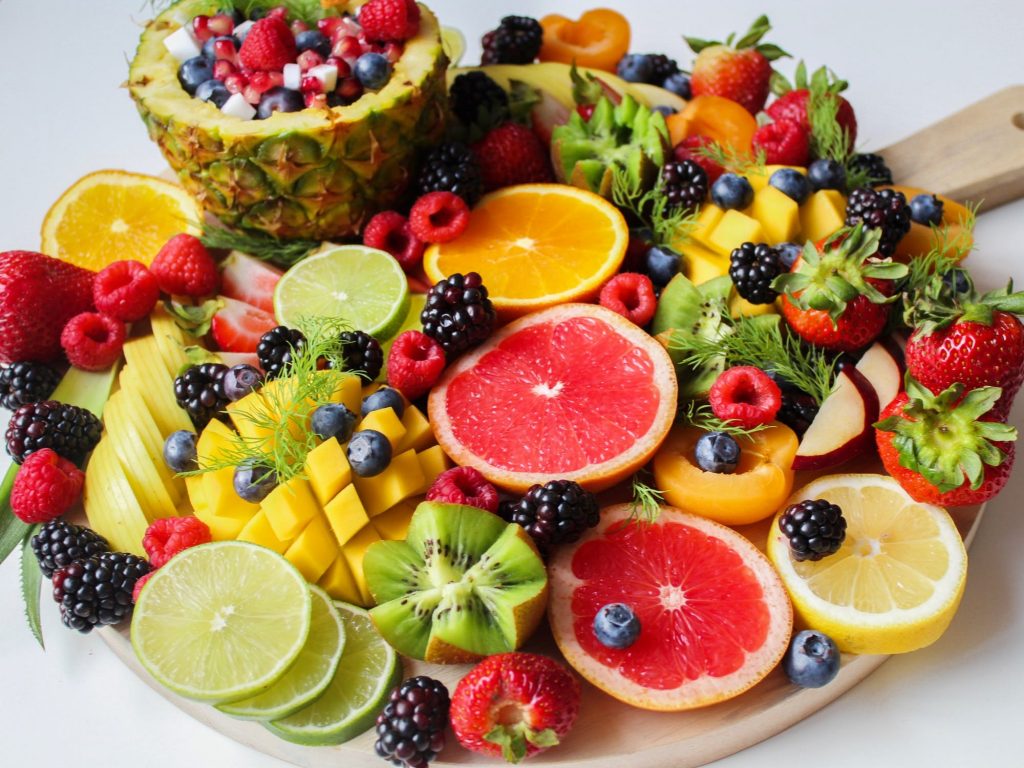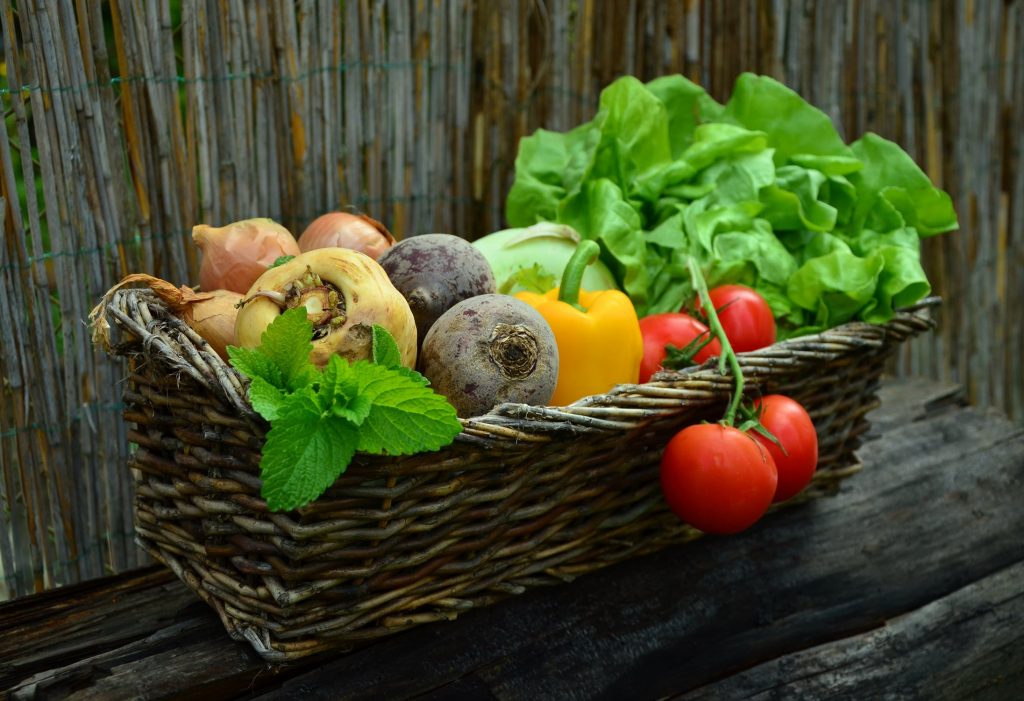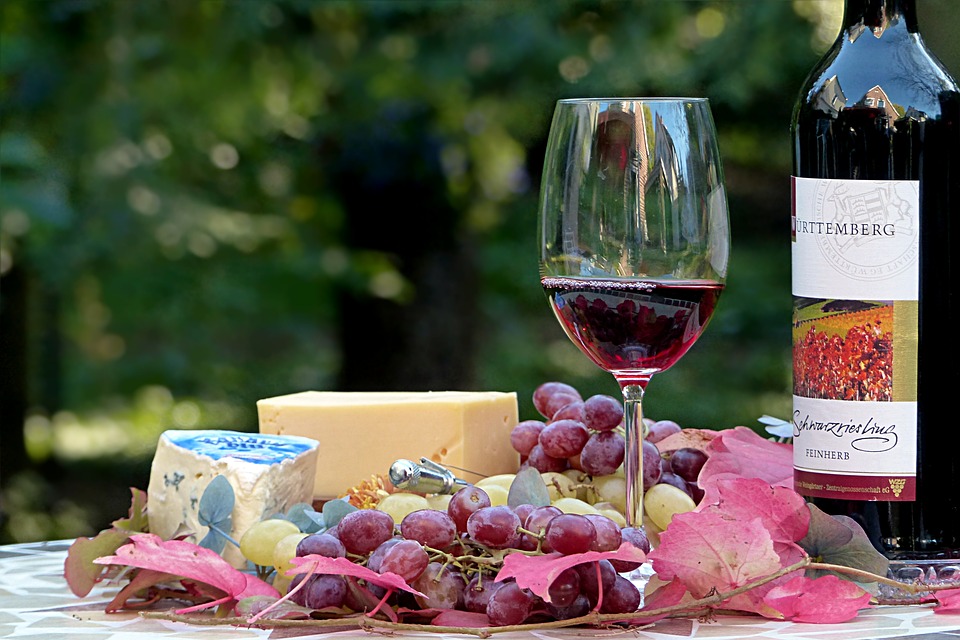 Food and drink vocabulary is a main staple of language learning. The names of foods in English might seem quite daunting as there are so many. A good way to start is to learn a few foods from the basic food groups. That way you can always create a meal!
Food and drink vocabulary is a main staple of language learning. The names of foods in English might seem quite daunting as there are so many. A good way to start is to learn a few foods from the basic food groups. That way you can always create a meal!
Foods are important to learn for when you go shopping or eat out at a restaurant. They are also useful for conversation when discussing what you are going to have for dinner. As we all need to eat food, learning the names for the foods is a great idea as this is something common to every language.
From fish and chips and roast beef to the traditional English breakfast! In this article we explore useful English food and drink vocabulary and traditional meals, mealtimes and foods in the UK.
Breakfast, Lunch and Dinner
The meals of the day can be split into early, afternoon and evening meals. In English, we generally call these breakfast, lunch and dinner. Small meals in between main meals are called ‘snacks’. A late evening meal is called ‘supper’. A mid-morning snack is called ‘elevenses’.
A late afternoon meal is called ‘tea’ and traditionally this is when sandwiches or cake and a pot of tea is served (called ‘afternoon tea’ or sometimes more formally, ‘high tea’). A ‘cream tea’ is an afternoon snack with a pot of tea, scones, jam and clotted cream – this tradition originated in Devon and Cornwall.
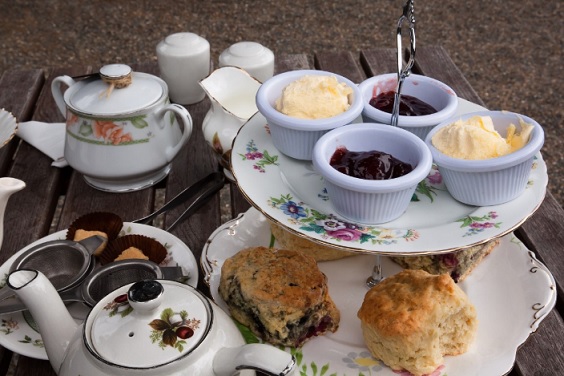
1. Cream tea with scones, jam, clotted cream and pot of tea – image source
Regional Differences in Meal Names
So remember that the word ‘tea’ in the UK can mean a cup or a pot of tea to drink but it can also mean an afternoon meal.
These words only offer a general guide, however, because the afternoon and evening meal can be called different names in different areas of the country. The regular evening meal can also be called ‘tea’ in the north of England, while some people call their dinner ‘supper’.
A main meal can be split into starter, main and dessert. The different parts of a meal are called ‘courses’. Desserts are sometimes called ‘sweets’ or ‘pudding’ or ‘afters’ if you are in the north of England.
The usual times for eating in the UK are between 12 noon and 2pm for lunch (1pm is usual), around 4pm for afternoon tea, and between 6pm and 8.30pm for dinner. Some people eat later than this, especially if going out for dinner.
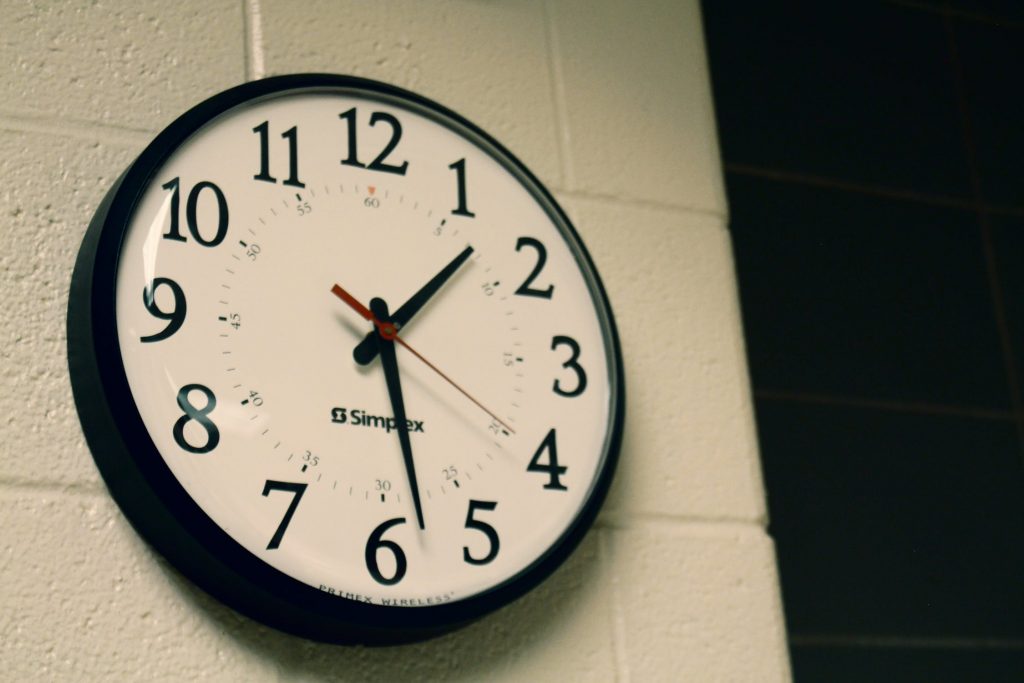
Lunchtime! – image source
Food and Drink Vocabulary
Foods can be split into food groups: carbohydrate, protein and fats. These are called the three macronutrients.
Fruit, vegetables and grains are examples of carbohydrates; meat and fish are examples of proteins; and butter and nuts are examples of fat (butter is animal fat and nuts are vegetable fat). We need all the three food groups in our diet to stay healthy.
Fruit vocabulary
- Fruit
- Apples, pears, bananas, plums, grapes
- Oranges, nectarines, clementines, satsumas
- Pineapple, mango, grapefruit, pomegranate, papaya, coconut
- Peaches, apricots, melons (honeydew, watermelon, cantaloupe, galia)
- Prunes, figs
- Avocados
- Strawberries, blueberries, raspberries, blackberries
Vegetables
Vegetables are also known as veggies or simply veg (pronounced ‘vedge’).
- Carrots, peas, potatoes, sweet potatoes, squash
- Cauliflower, broccoli, spinach, peppers
- Onion, garlic, mushrooms
- Salad, lettuce, tomatoes, cucumber, beetroot, celery (some say these salad foods are technically fruit)
- Aubergine / eggplant (American)
- Courgettes, asparagus
- Beans, lentils
- Nuts, seeds
Grains
Bread, pasta, rice, cereals
Dairy
Cheese, milk, butter, margarine, eggs, cream, yoghurt / yogurt
Meat
- Lamb, chicken, turkey, pork (meat from a pig), beef (meat from a cow)
- Bacon, ham, gammon, sausages, salami (all types of processed pork, although sausages can sometimes contain other meat and you can also get vegetarian sausages)
- Venison (meat from a deer), pheasant, goose, rabbit, duck (all types of game)
- Tripe (stomach), kidney, liver, tongue (all types of offal)
Steak is a cut of meat made from beef muscle, usually cooked on a grill or in a frying pan. Steak can be cooked is a variety of ways depending on how well cooked the diner prefers their meat. When ordering steak in a restaurant, you will be asked how you want it cooked. Options for cooking steak, from lightest to most well cooked, are:
- blue (bleu) – very rare, red inside and lightly seared on the outside, full of juices
- rare – red inside, juicy
- medium rare – slightly red inside, quite juicy
- medium – pink inside, only slightly juicy
- well done / medium well – mostly brown with hint of pink, not juicy
- very well done – brown all the way through with no pink, no juice
Fish
Cod, plaice, haddock, salmon, tuna, sardines, mackerel, anchovies, halibut, trout, lemon sole, sea bass, swordfish
Scampi, mussels, clams, prawn, squid (all types of seafood)
Oils
Sunflower oil, olive oil, avocado oil, rapeseed oil
Herbs and spices
- Basil, oregano, parsley, chives
- Rosemary, thyme, sage
- Turmeric, cumin, marjoram, curry powder
- Paprika, ginger, cinnamon
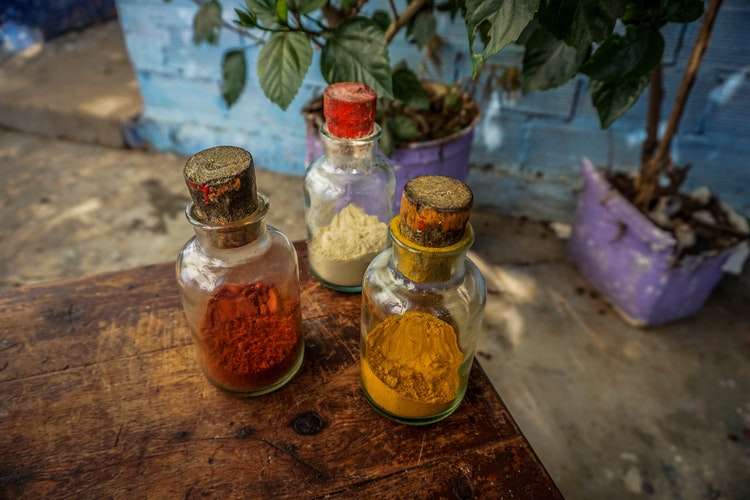
Pots of spices – Image source
Breakfast foods
- Cereal, porridge, toast and butter, toast and marmalade, toast and jam, croissant, bagel (American), fruit
- Milk, orange juice, grapefruit juice, tea, coffee
Many Europeans eat ham and other cold cooked meats for breakfast, but this is quite rare in the UK.
No food and drink vocabulary guide for English learners could be complete without a mention of the full English breakfast.
The full English breakfast is a traditional breakfast in England that is very rich and quite high in fat, so it is not a good idea to eat one every day! It is also not convenient for the busy modern lifestyle, as it takes time to cook.
This ‘breakfast’ is sometimes eaten as a brunch (a meal between breakfast and lunch) or as a treat at the weekend
A ‘full English’ includes some or all of the following:
- bacon, eggs, sausage
- hash browns, fried bread
- baked beans, tomato, mushrooms
- black pudding
- tomato ketchup or brown sauce
- tea or coffee, orange juice
Some people are very particular about the arrangement of the food on the plate with some finicky diners opting to use the sausage as a ‘break-water’ between the beans and egg.
Some English breakfast enthusiasts insist on scrambled egg over fried egg, while others require the addition of black pudding and various sauces (e.g. ketchup).
Most people would want a cup of tea and some toast on the side, served with butter and marmalade or jam.
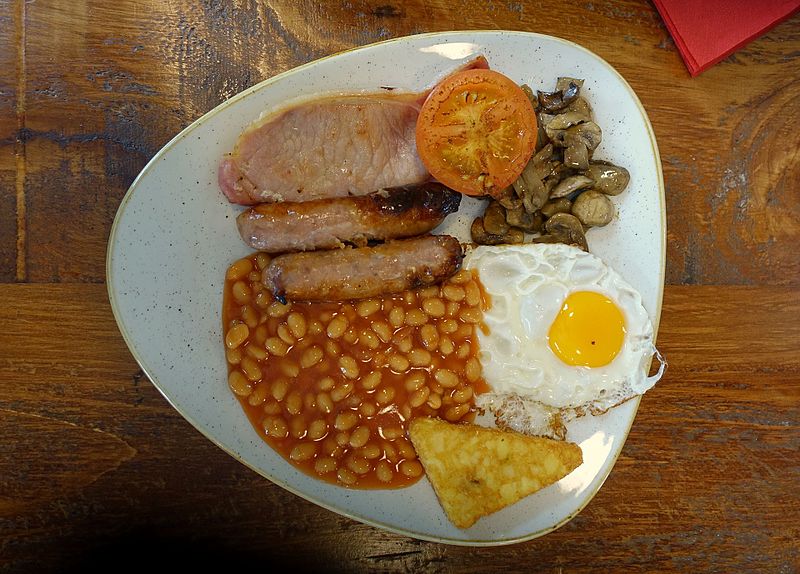
2. A delicious full English breakfast – fried egg, sausages, grilled tomato, bacon, mushrooms and hash brown – image source
Traditional English Food
Fish and chips is one of the most famous British meals. You buy this meal at a fish and chip shop or ‘chippie‘.
This meal traditionally consists of cod or haddock in batter with thick chips, all wrapped in grease-proof paper (this used to be newspaper in the old days) and mushy peas. You can also get curry sauce to put on your chips. The chippie serves other meals too, such as pies and gravy, fish cakes, sausages and sometimes even pizzas and wraps.
Pie is a traditional British food – a pastry crust filled with meat and vegetables. Common pie fillings include beef and onion, steak and kidney, chicken and mushroom, and steak and ale.
Other traditional English foods include cottage pie (mince beef with mashed potato on top) and shepherd’s pie (mince lamb with mashed potato on top).
There are many regional foods which are common across the UK. However, steak and chips is always popular!
![Fish, chips and mushy peas in London by Charles Haynes from Bangalore, India (Fish, Chips, and Mushy Peas) [CC BY-SA 2.0], via Wikimedia Commons Food and drink vocabulary - fish and chips](https://www.myenglishlanguage.com/wp-content/uploads/2018/06/fish-and-chips.jpg)
3. Fish and chips – battered fish, chips, mushy peas, tartare sauce and a slice of lemon – image source
Fast food
Burger, hot dog, chips, sausage, crisps, sandwich, pizza, noodles, fish and chips (a ‘fish and chip supper’ is traditional English fast food!)
You can also buy ‘ready meals’ which are full meals, often frozen, designed to be cooked quickly in the microwave and be ready to eat in a few minutes.
Desserts
(Be careful you don’t get the words dessert and desert confused!)
Cake, doughnut, pastry, mousse, ice cream, biscuits, cookies, chocolate, sweets
Drinks
Water, milk, juice, squash / cordial, pop (fizzy drink), cola, lemonade, hot chocolate, tea, coffee, milkshake
Alcoholic drinks
Wine (red, white, rosé), beer (ale, bitter, stout, mild), cider, spirits, alcopops, brandy, whisky (scotch, bourbon), liqueurs, cocktails, gin, rum, vodka, punch, mulled wine, gin and tonic, martini
A ‘mixer’ is a non-alcoholic drink added to an alcoholic drink to make it a ‘long’ drink (i.e. larger in volume), such as whisky and cola.
‘Straight’ means an alcoholic drink served without a mixer
‘On the rocks’ means a drink served with ice. For example: ‘Scotch on the rocks’
International influence
In the UK, a traditional meal was always ‘meat and two veg’, which was usually meat with potatoes and a vegetable, often carrots and peas.
This way of eating was very much the usual British meal in the 1950s. But after the 1960s, international cuisine found is way to the UK and our palates developed to include more daring foods, from Italian pasta and Thai curries to Japanese sushi and American hot dogs and bagels.
Indian curries are some of the most popular meals in the UK, especially chicken tikka masala.
Nowadays people in the UK eat a wide variety of foods from all over the world and our diets are all the more exciting because of it.

A selection of sushi – image source
The Traditional Roast Dinner
A tradition has never died out in the UK, however, is the roast dinner. This is traditionally eaten on Sunday (because it takes a long time to cook and all the family are typically at home).
The ‘Sunday roast’ consists of a roast meat (beef, lamb, chicken or pork – but turkey or goose at Christmas!) along with roast potatoes and a selection of vegetables and sauces.
The other foods included in a roast dinner typically depend on the type of meat, which is always the centre piece. Here are some traditional English roast dinners:
- Roast beef dinner: Beef, Yorkshire pudding, roast potatoes, other vegetables (normally including carrots), gravy, mustard or Horseradish sauce
- Roast chicken dinner: Chicken, roast potatoes, roast parsnips, vegetables, cranberry sauce, bread sauce
- Roast lamb dinner: Lamb, roast potatoes, vegetables, mint sauce
- Roast pork dinner: Pork, roast potatoes, vegetables, apple sauce.
As you can see, the typical roast dinner always has the roast meat and roast potatoes (although if you wanted to be healthier, you could serve boiled potatoes). The main change for each meal concerns the sauce.
Plus, roast beef always comes with Yorkshire pudding (a side dish made from eggs, flour and milk) – without this important ingredient any English person will not believe it a ‘proper’ roast beef dinner!
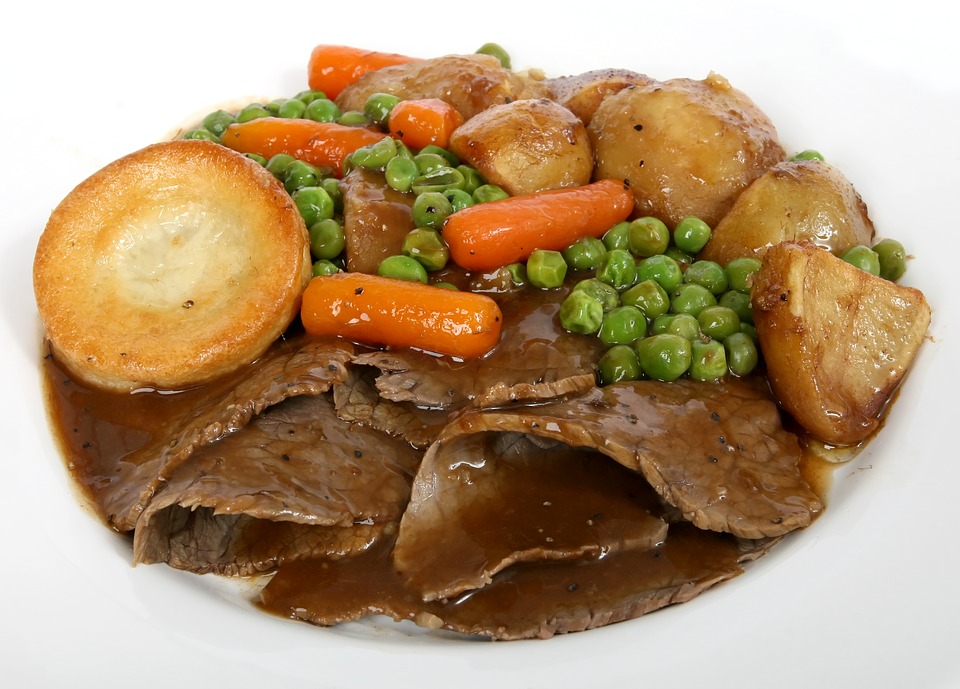
Roast beef with Yorkshire pudding – image source
Methods of cooking
- grill / broil – to cook by exposure to heat, under a grill
- bake – to cook in an oven by dry heat, without direct exposure to a flame, often the food is covered
- roast – to cook in an oven or over an open fire, typically the food is uncovered
- boil – to cook in boiling water
- sauté – to cook by frying quickly in a small amount of hot fat or oil
- fry – to cook in fat using a shallow pan / frying pan
- chargrill – grill at a very high heat
- stirfry – fry quickly while stirring
- steam – cook by heating food in the steam over boiling water
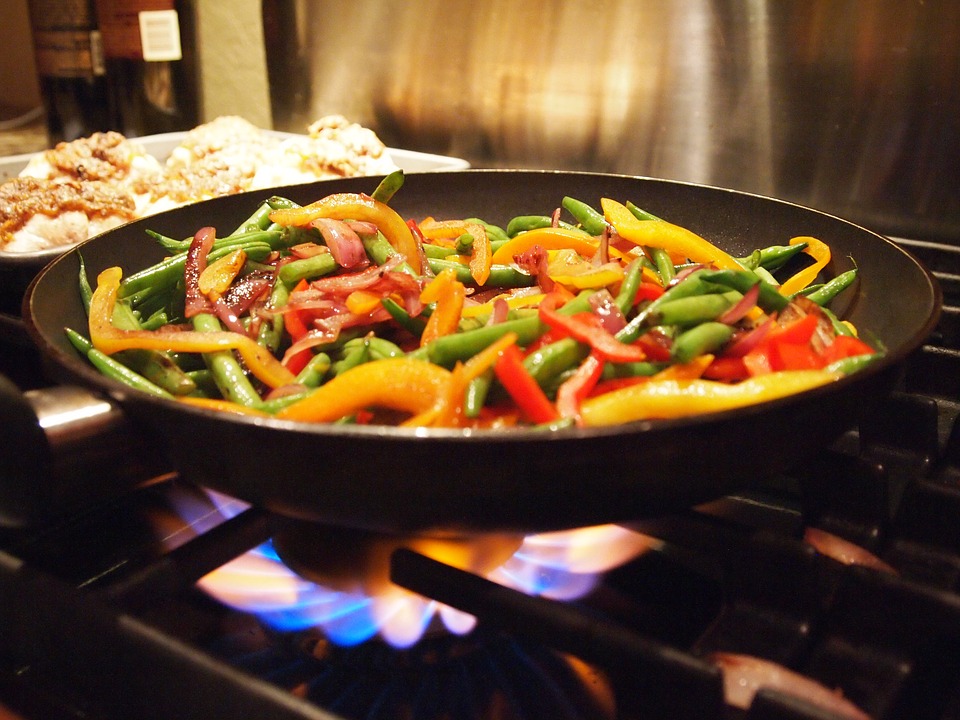
Cooking peppers in a frying pan – a veggie stir-fry – image source
What do you think about food and drink vocabulary?
What are the traditional foods of your country?
What are your favourite foods and drinks?
Do you enjoy any traditional English dishes?
Do you find any words related to food and drink confusing?
Let us know your thoughts about food and drink vocabulary in the comments!
Attributions
- Cream tea via pxhere [CC0 Public Domain]
- English breakfast – Great Haywood, Staffordshire, England. Image by Daderot [CC0], from Wikimedia Commons
- Fish, chips and mushy peas in London by Charles Haynes from Bangalore, India (Fish, Chips, and Mushy Peas) [CC BY-SA 2.0], via Wikimedia Commons

